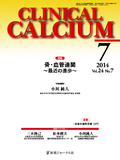Japanese
English
- 有料閲覧
- Abstract 文献概要
- 1ページ目 Look Inside
- 参考文献 Reference
糖尿病では,老化のプロセスが進行し,心血管合併症や骨粗鬆症,アルツハイマー病,癌などの発症リスクが上がってくることが知られている。最近,これら疾患発症の共通の分子基盤に糖化反応の亢進,つまり終末糖化産物(advanced glycation end products:AGE)の形成,蓄積が関わっていることが明らかとなってきた。AGEは,細胞表面受容体であるRAGEによって認識され,酸化ストレスや炎症反応を引き起こし臓器障害を招くだけでなく,コラーゲンなどの生体内蛋白を悪玉架橋させ,各種疾患の進展・増悪に深く関与する。さらに,食事や喫煙などに由来する外因性のAGEの過剰摂取が臓器障害や老化のプロセスを押し進めることが,実験動物やヒトを対象とした臨床研究などから明らかにされてきている。 本稿では,骨・血管連関におけるAGE-RAGE-酸化ストレス系の役割について解説し,骨粗鬆症と動脈硬化症を標的とした新しい治療戦略に関しても言及していく。
A non-enzymatic reaction between reducing sugars and amino groups of proteins, lipids and nucleic acids contributes to the aging of macromolecules. Over a course of days to weeks, early glycation products undergo further reactions such as rearrangements and dehydration to become irreversibly cross-linked, fluorescent protein derivatives termed advanced glycation end products(AGE).The formation and accumulation of AGE have been known to progress at a normal physiological aging and at an accelerated rate under diabetes. Recently, the risk of various age-related disorders such as cardiovascular disease, osteoporosis, Alzheimer's disease, and cancer have been reported to increase in patients with diabetes. There is a growing body of evidence that AGE and the receptor RAGE interaction elicits oxidative stress generation and subsequently evoke inflammatory and thrombogenic reactions in a variety of cells, thereby contributing to the progression of these devastating disorders. Further, food- or smoking-derived AGE have also been shown to promote the aging-associated organ damage in humans. These observations suggest that inhibition of the AGE-RAGE-induced oxidative stress generation might be a novel therapeutic target for slowing down the aging process and achieving a successful life. In this paper, we discuss the role of AGE-RAGE-oxidative stress and its therapeutic interventions in osteo-vascular disorders.



